
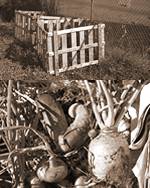
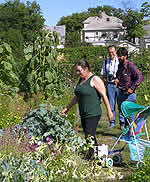
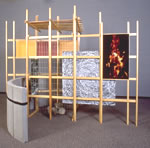
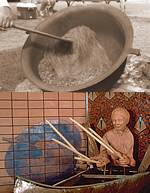
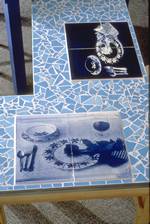
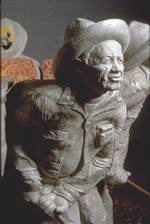
Case Study on Celebration of Stories
Margaret A. Adamek
The land grant university was founded to serve all people of the United States, particularly those who had close ties to the land and food production. These institutions of higher education have profoundly impacted food supply and quality worldwide for the last century. Land grants also enjoy a very clear and powerful civic dimension to their originating mission — one that informs the nature and content of their research, education and outreach programs. In recent years nationwide, a consortium of land grant universities have collectively endeavored to face the changing complexities of our global society by embarking on a journey of learning around how to create and sustain institutional change. As we explored how to practically apply principles of transformation, we turned in part to the arts to help us inquire, observe, analyze, and interpret how change happens most effectively in communities and public institutions. In the context of the land grant, a public art approach made deep sense, allying the goal of civic practice with community impact — both key underpinnings of the programs and spirit of our land grant universities.
Much like scientific inquiry, art is about the creative and rigorous observation and interpretation of how things work. Where science expresses its findings through formulas, art expresses its findings through artworks. Yet the goals and impacts of these disciplines on society are identical — both in purpose and depth. Scientific research in the land grant context is designed to benefit the public good, not just individual faculty interest. In the same vein, public art is constructed to involve and benefit citizens by creating avenues to seek and develop meaning around issues designated as important by stakeholders. This marriage of inquiry and democratic practice, of the commonwealth and public organization are key features that public art and the land grant university hold in common. And the practice of public art, as a convening and facilitating process, holds great promise as a means to involve stakeholders in public agenda-setting, pose important questions that we face as a society, and creatively address contexts and situations that are important to the common good.
Creating change in higher education
Over the last several years, numerous midwestern land grant universities (historically white and tribal) embarked on a joint endeavor to change the way that higher education worked. This challenge was rooted in the most traditional elements of the land grant university — colleges of agriculture — in the hopes that both the academy and the food system would change toward a more environmentally sustainable, community-connected and diverse set of programs and research. One project in the constellation of efforts sponsored by "Visions for Change" was the ‘Celebration of Stories’ public arts program. The goal of the public arts project was to involve the diverse communities across the region — from agribusiness to family farms to southeast Asian growers to biotechnology researchers to students to inner-city gardeners to organic farmers to Latino migrant workers — through sharing their stories and connections to the landscape and the food system.
Public art as a model for institutional change
The artists involved approached Visions for Change much the way other stakeholder groups did — with a good idea and a commitment to contribute to the greater civic good. Their proposal for a public arts project resonated with the Steering Committee, a group of university and community collaborators, for several reasons. The public arts approach reflected the civic and democratic roots and aspirations of the land grant institution. Their proposed process also demonstrated a practical example of how dialogue and collaboration between universities and communities could transpire. Out of the process could emerge shared meanings, new stories and possibilities for partnership that were a means of informing the broader agenda of these public institutions.
As an administrator with no arts experience and little understanding about the distinction between public art and other arts practices, I learned a tremendous amount about the capacity for public art programs to build community, create culture, and promote positive institutional change. I also learned some critical lessons about what it means and how it works to undertake a community development project that is arts-based (not arts-focused), which was new territory for me. These aspects involved fund-raising, curation, exhibit scheduling, and administrative aspects of overseeing an arts project.
Stories of food and the land
The Celebration of Stories arts project gathered stories from numerous stakeholders within the regions food system as the first phase of the project. The idea behind this storygathering phase was to collect images, metaphors and compelling language around our shared and different connections to the landscape and food. The artists were deeply moved by the stories that they heard and crafted a visual piece (a large poster) that was distributed to all donors and participants in this phase. Funds to subsidize this process (about $15,000) were raised internally at the University of Minnesota, with several collegiate units offering a modest matching amount.
From one of the unit directors, I was pointed toward the Cultural Outreach Coordinator in the College of Liberal Arts, who helped refine our thinking around a second phase and assisted us in raising significant monies to support construction of sculptures and exhibitions. A VFC Steering Committee member also assisted with raising funds from a local agribusiness concern to support the work. The University then contributed studio space on campus to provide more exposure of the works-in-progress to the campus community.
The artists created five sculptural works that touched on different geographies, stories and experiences of the food system across the region, from the migrant experience, to agricultural history, to the plowing of the prairie, to Native American wild rice harvests to the urban-rural interface. These works have been displayed at conferences and meetings as well as at the corporate headquarters of the involved agribusiness. We are currently working on the final stages of securing funding and scheduling the exhibits. These exhibits are designed to be sited in the communities and universities that were involved with the overall program. The idea is to celebrate through images and metaphors the rich diversity of experience and stories of food and the land in our region and the critical role that the land grant university has played in this human story.
This process has taken over three years from conception to implementation. There have been wonderful surprises, several pitfalls and some exciting outcomes. Having never done this type of work before, I have learned some important lessons worth sharing:
- Public art money is easier to raise through non-conventional sources. Typical grants programs for the arts do not understand neither the civic dimensions nor the processes involved in public art. Institutional allies and departments and foundations that invest in community development are better sources. Fundraising in this way also involves a greater number of advocates and stakeholders in the process.
- Seek partnership with the arts entities in your institution, but maintain clarity on what the principles and practice of public art are all about. Our university art museum was very helpful in providing appropriate contract language, offering assistance on publicity and suggestions for maintenance, as well as connections to helpful resources locally. Public art, as we are discussing it, is unusual for the art world, however, and allying oneself with the civic roots requires extensive dialogue.
- Consider an unorthodox artist selection procedure. Typical juried applications and artist selection processes don’t necessarily work in this case. Artists should really understand and have deep experience with facilitation of community conversation and co-creation of the artworks with the stakeholders. Many artists, who may be very accomplished in their medium, don’t have this background. Choose carefully! It’s a tricky balance to strike between accomplished artists and accomplished civic practitioners — you’re looking for the best of both worlds…..Ask around.
- Scheduling exhibits must be done several years in advance. I didn’t know anything about this! Working with museum directors and key upper-level administrators can help museums get excited and willing to assist with finding appropriate exhibit space and scheduling the exhibits.
- Build ways for the public art process to involve as many diverse stakeholders as possible. While the final artwork will be wonderful, peoples’ memories of their own stake in the conversation and meaning-making will be just as critical. There are lots of creative ways to do this. Creating seminars, brown bags and studio sessions with the artist really do interest people and are great ways to get them involved.
- Administrating and fundraising for public art is this interesting balance between standard community development work and standard arts administration. It is both and neither!! The fundraising tactics of community development apply more ideally in this kind of undertaking, while the administration practices from the artworld are better suited. An alliance of both types could be very helpful in creating a successful program.
Public art, when it is done well, is about developing meaning around issues of importance to a community. This meaning not only results in fine art (performing or visual), but also creates cultures and builds the skills of a community in dialogue, meaning-making and problem-solving. I have been amazed to watch how interested and creative people will get when they begin this collaboration with a public artist. I am also keenly interested in the potential of public art to invok.